I guess there are a few differences between the two parts sets, looks like you are having fun, sometimes it is hard to stop once you get started, enjoy the experience and the end result, these guns are nice to shoot I am certain you will not be dissapointed.
-
Friends, our 2nd Amendment rights are always under attack and the NRA has been a constant for decades in helping fight that fight.
We have partnered with the NRA to offer you a discount on membership and Muzzleloading Forum gets a small percentage too of each membership, so you are supporting both the NRA and us.
Use this link to sign up please; https://membership.nra.org/recruiters/join/XR045103
You are using an out of date browser. It may not display this or other websites correctly.
You should upgrade or use an alternative browser.
You should upgrade or use an alternative browser.

Help Support Muzzleloading Forum:
This site may earn a commission from merchant affiliate
links, including eBay, Amazon, and others.
Pittsburghunter
50 Cal.
- Joined
- Apr 28, 2005
- Messages
- 1,344
- Reaction score
- 39
As far as those screws go could they be "working screws"? My Hawken kit came with steel screws installed that you are suppose to replace when done with finishing the parts. It has brass screws to put in when finished.
That looks like quite a project, good luck.
That looks like quite a project, good luck.
Guest
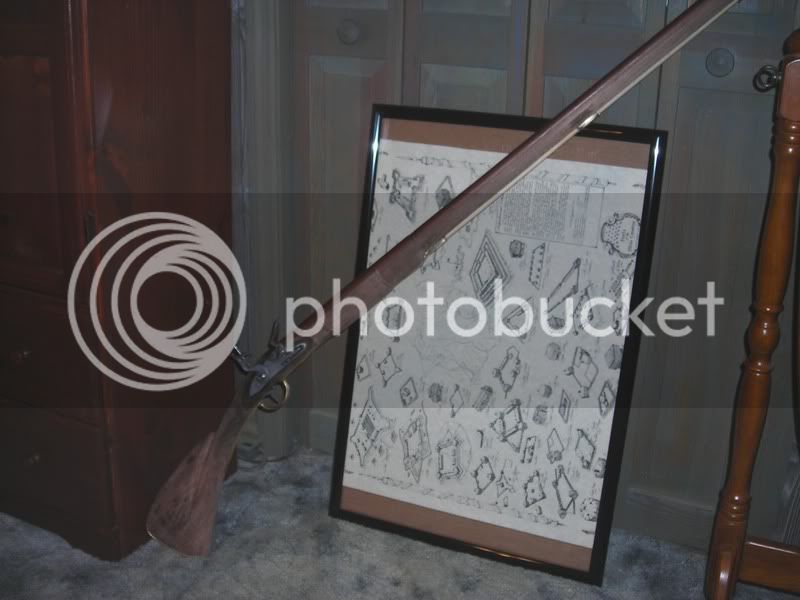
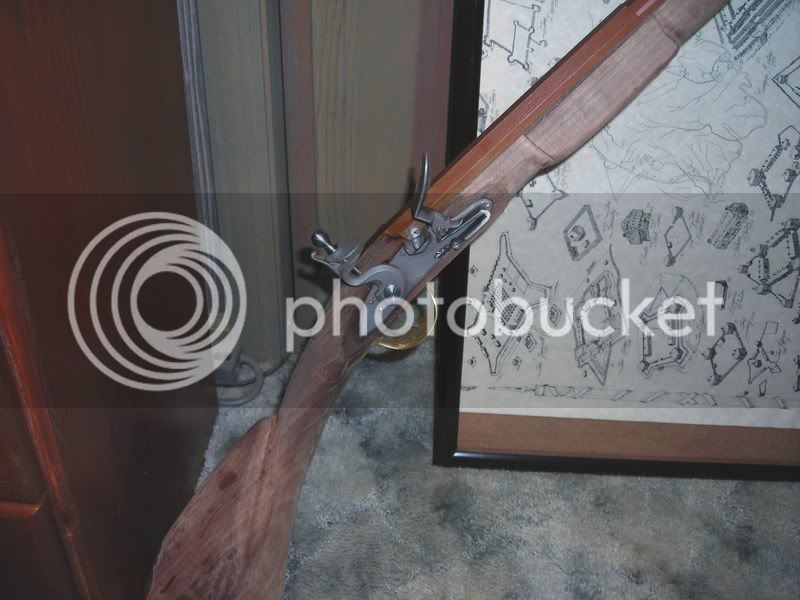
All I have left is to shape the forearm and stain.
DougMPhoto
40 Cal.
- Joined
- Oct 27, 2006
- Messages
- 127
- Reaction score
- 0
"Then I purchased some basic wood carving tools.
File sets, dremel, etc."
DREMEL???? My M/L building instructor (local comm. College) would have a fit!! :nono: To break the quiet sometimes in class I would "threaten" to pull out my Dremel" and the class would laugh. :rotf:
He would always say.."they didn't have Dremel's back when" And I would say "If Dremel's were made back then...they would've used them." Another laugh.
Tulle looking good. :hatsoff:
PAMuzzleloader :thumbsup:
File sets, dremel, etc."
DREMEL???? My M/L building instructor (local comm. College) would have a fit!! :nono: To break the quiet sometimes in class I would "threaten" to pull out my Dremel" and the class would laugh. :rotf:
He would always say.."they didn't have Dremel's back when" And I would say "If Dremel's were made back then...they would've used them." Another laugh.
Tulle looking good. :hatsoff:
PAMuzzleloader :thumbsup:
Mike Brooks
Cannon
- Joined
- Jul 19, 2005
- Messages
- 6,686
- Reaction score
- 32
You've got quite a bit of wood that needs to come off from the front of the lock backi to the buttplate too.... :winking:All I have left is to shape the forearm and stain.
TVLLE KIT
All of that carving should be gone by the time you get it down to "proper" size. The wrist should be no more than about 1 3/8" tall just in front of the comb and a little less than 1 1/2" wide at the same point. These were very slim guns. see if you can work some of the hump off the top of the buttstock, it's a little too exagerated in this kit.
When you shape the fore stock, leave less than 1/2 of the barrel exposed and less than 1/2 of the ram rod exposed[url] too..In[/url] other words take a bunch of wood off the top and bottom of the stock to expose more barrel and ram rod. The lower forestock should be 1/8" on either side of the barrel and 1/16" on the upper forestock.
EDIT: Never mind, I see from your other post I'm too late......
Last edited by a moderator:
Guest
Thanks for the info Mike.
I took some more off this morning and restained.
I guess Im afraid of taking to much off.
I know what you mean by a slim rifle.
I see the ones that are made in India and they look like blocks of wood.
Not very attractive.
Ill post some more pics later.
I took some more off this morning and restained.
I guess Im afraid of taking to much off.
I know what you mean by a slim rifle.
I see the ones that are made in India and they look like blocks of wood.
Not very attractive.
Ill post some more pics later.
Tom
As you know now to keep that gun a light as possible you might want to get the wood along the barrel on the forestock to about 1/16" thick. Also on a French gun the forestock between the lock panels and the rear ramrod pipe should be Vee shaped, in cross section, rather than rounded as the kits most generally come. This will lighten the gun and also make it a lot more graceful in keeping with the originals
Best wishe on your project.
Regards, Dave
As you know now to keep that gun a light as possible you might want to get the wood along the barrel on the forestock to about 1/16" thick. Also on a French gun the forestock between the lock panels and the rear ramrod pipe should be Vee shaped, in cross section, rather than rounded as the kits most generally come. This will lighten the gun and also make it a lot more graceful in keeping with the originals
Best wishe on your project.
Regards, Dave
dvlmstr said:Tom
As you know now to keep that gun a light as possible you might want to get the wood along the barrel on the forestock to about 1/16" thick. Also on a French gun the forestock between the lock panels and the rear ramrod pipe should be Vee shaped, in cross section, rather than rounded as the kits most generally come. This will lighten the gun and also make it a lot more graceful in keeping with the originals
Best wishe on your project.
Regards, Dave
I agree with both Mike and Dave here as to the slimness and grace of these guns. As to Dave's comment on the "V" configuration between the panels and the rear entry pipe, I took a look at my old guns and they are more " U " shaped.Also the wood from the lock and side plate all the way out is virtually the same thickness beside the[url] barrel.In[/url] other words there is "VERY" little thickness to the forestock wood. Granted,however, that my guns are Fusils fin de chasse made in Liege and shipped to New France,I doubt there is much difference between them and the Fusils de chasse made by Tulle and other makers.These latter plain de chasse guns may not be quite as slim in the forestock as the fin de chasse guns but I doubt there is much difference. As Mike has correctly pointed out these guns both the plain as well as the fin guns were EXTREMELY slim graceful guns.Also the wood beneath the lock plate is also very thin.TG is correct on the absence of browning on these guns.Dave is also right in that iron screws are virtually{I hate the word "never"}always used on these guns.I noted,too, the use of a R E Davis. That is the slightly earlier of the two {L&R and R E Davis} locks but it also needs some tweaking to the cock and frizzen. The latter needs it on the back of the frizzen as well as the base and the cock needs to lose the small tit just above the cock screw. I would also round off the heads of the external screws.As I said,these are juist some thoughts on the matter.
Tom Patton
Last edited by a moderator:
Guest
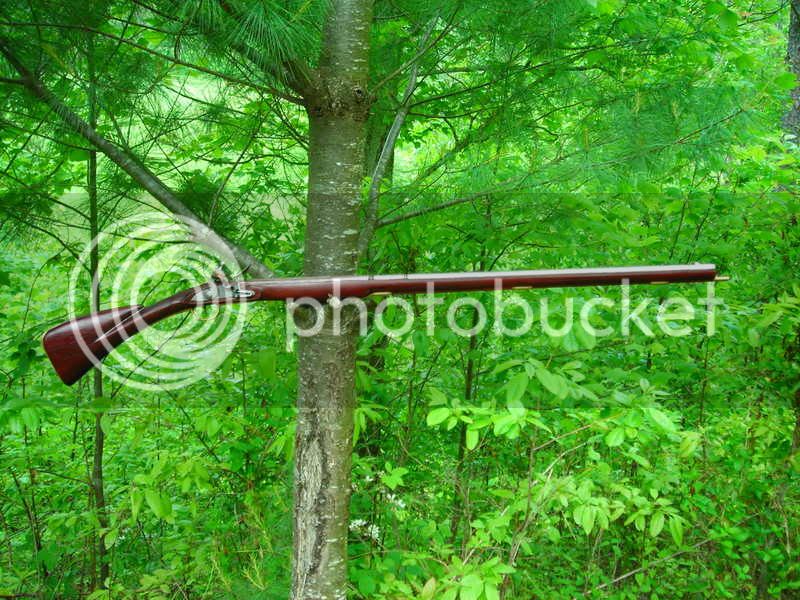
After I took these photos I have it back on the bench taking off more wood.
Can you guys look these over closely and tell me anything else that might need to be done.
Thanks again for everyones assistance.
If not for you guys and this site I would have never attempted this project.
This is my first attempt ever at building a gun kit and I appreciate everyones advice.
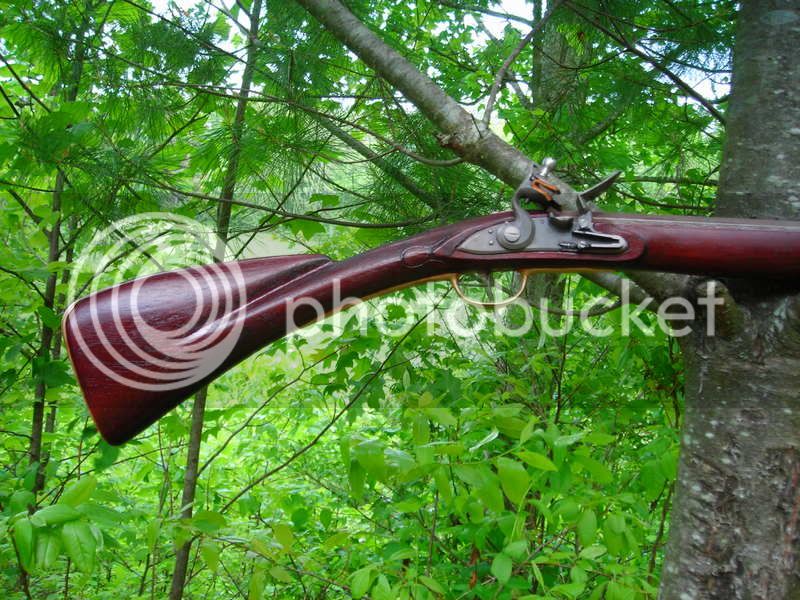
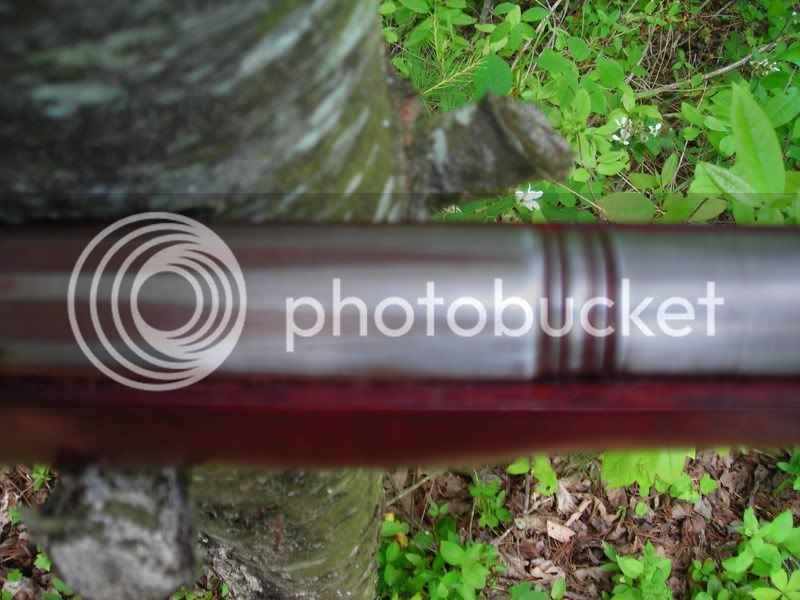
I removed about 90% of the browning.
I am trying to give the barrel an antique type finish.
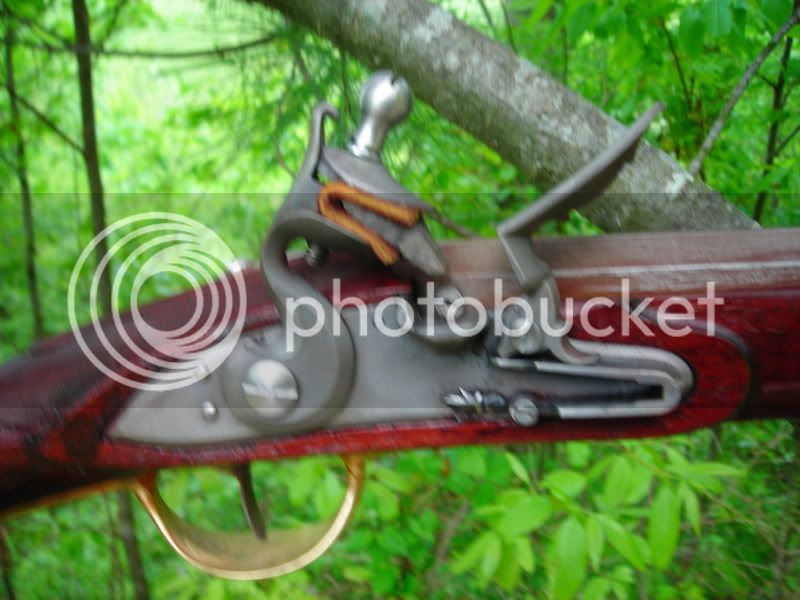
I took it out and fired it this morning. Ignition was perfect.I was afraid I had drilled the touch hole about a 32nd to high.
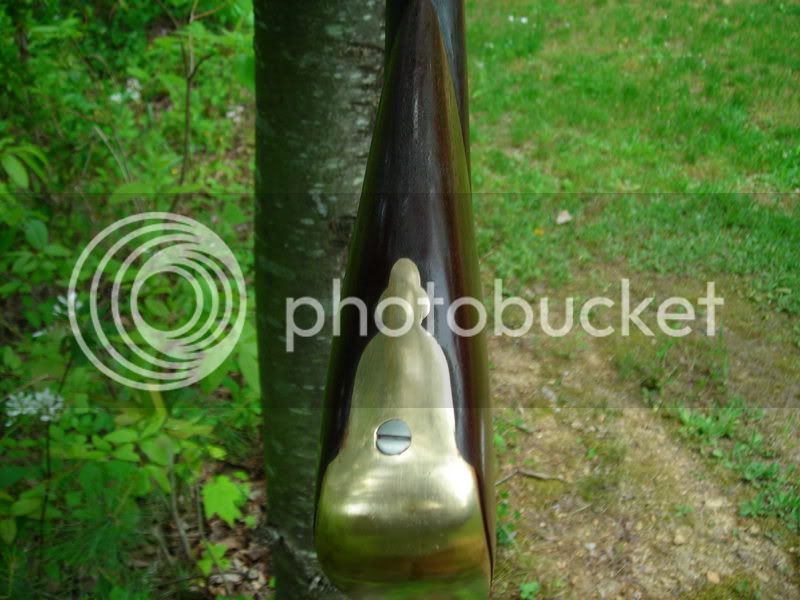
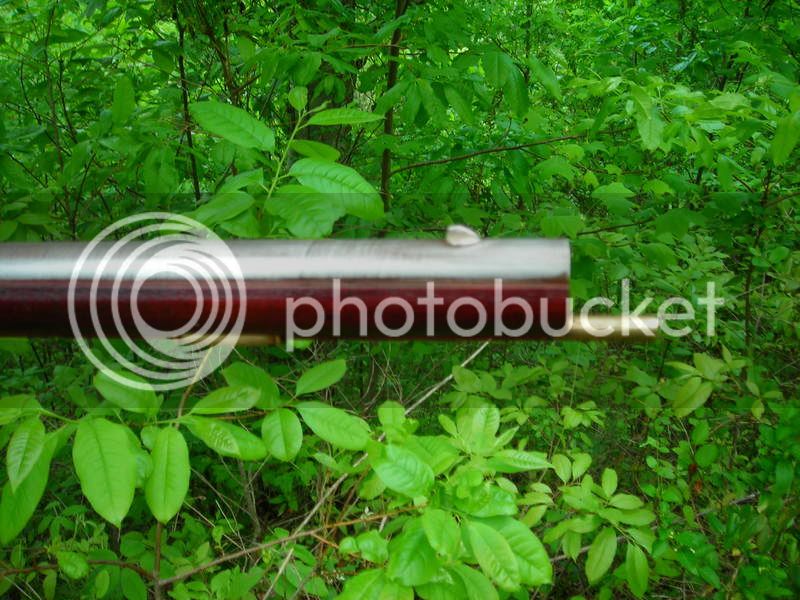
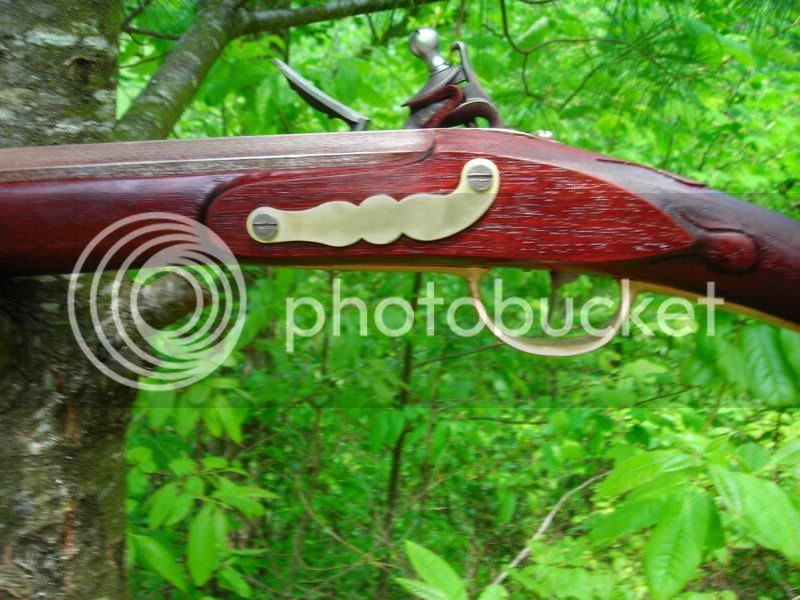
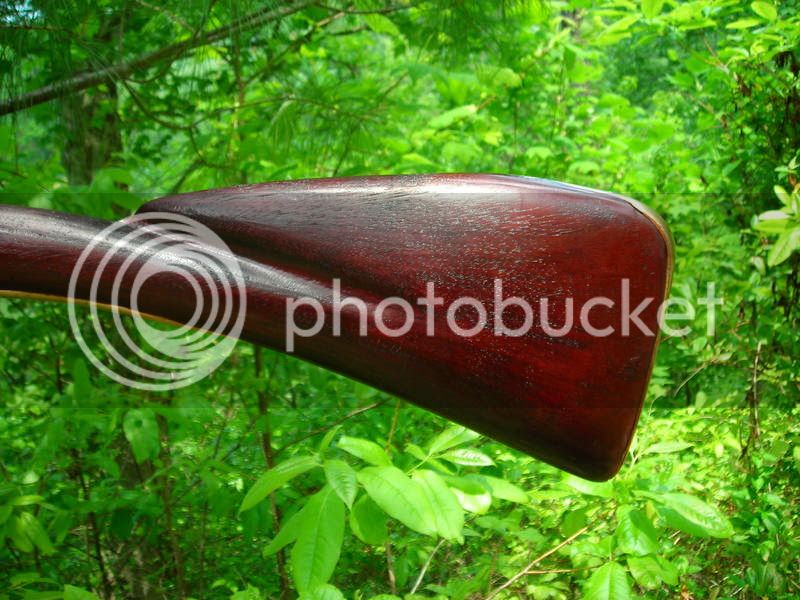
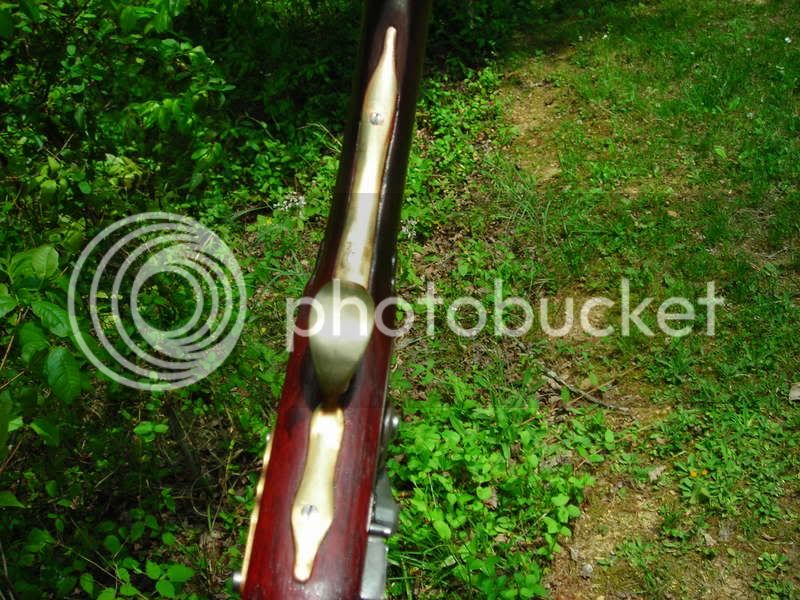
...when i put together my caywood wilson trade gun kit i did like you and got r done...thought it looked real good, after a while i learned more from reading these posts...critiques... and in four years since have reworked the wood and metal down to a fairly slim and more elegant gun...it's your gun and your work, keep at it , that's how we learn, and what a craftsman does...i make high end jewelry in real life...gold, diamonds, platinum... and it's taken me 30 years to get good at it...these people here that offer criticism and advice are lending us some of their hard earned experience...tho' sometimes i'm a horses -ss...i am grateful...but the bottom line is it's your gun, do with it as you like and have fun. :thumbsup: :thumbsup: :thumbsup:
- Joined
- Feb 2, 2005
- Messages
- 1,376
- Reaction score
- 244
I think you did a nice job on the smoothie. I've seen guns built by guys who have done several not look that nice. I love the lines of that French gun and have just ordered a pre-carved stock from Stonewall Creek outfitters and plan on matching it with a .62 cal 44" barrel when I'm done with the Chambers kit I'm working on. TG after seeing the pics of your Virginia rifle and Fusil de Chasse I thought that would be a good choice of two guns to have. By the way I'm blaming you When the wife gets the bill :blah: :blah:
I think the tip of the stock at the muzzle should taper down over the last few inches. Also the forestock needs a lot of slimming down. I am presently building a fusil de chasse too. The first couple guns I built I rushed through, only to tear them down and remove more wood a couple of times. I have vowed to slow down and get this one the first time.
paulvallandigham
Passed On
- Joined
- Jan 9, 2006
- Messages
- 17,538
- Reaction score
- 87
I do believe that the most common woodworking mistake new gun builders make is leaving too much wood in the forestock, and forgetting to taper the stock from the entrypipe, to the muzzle, on both the top and bottom. Most of us grew up with modern guns, where the stocks are used to SUPPORT the BARREL. When you get into muzzle loaders, its hard to make the mental shift to understanding that the wood is simply hung from the barrel, acting as a thin barrier from dents and nicks, and scratches. It does not support the barrel. The barrel supports the stock!
Gun builders are also seduced by the remaining wood around the ramrod channel, thinking the wood must be left in order to guide the ramrod down the ferrels. Because the first rerrel is so close to the muzzle, you can get by with just a hint of the original cut of the ramrod channel, and remove all the rest of the wood to present a thin piece at the muzzle. The ferrels guide the ramrod, and not the ramrod groove. Taper, but remove most of the wood from the sides of that channel to give the wood a more oval appearing shape in the forestock, rather than a round, or rectangular appearance.
Gun builders are also seduced by the remaining wood around the ramrod channel, thinking the wood must be left in order to guide the ramrod down the ferrels. Because the first rerrel is so close to the muzzle, you can get by with just a hint of the original cut of the ramrod channel, and remove all the rest of the wood to present a thin piece at the muzzle. The ferrels guide the ramrod, and not the ramrod groove. Taper, but remove most of the wood from the sides of that channel to give the wood a more oval appearing shape in the forestock, rather than a round, or rectangular appearance.
First off, I think you've done an AMAZING job so far, specially so since you just got the kit what ... a week ago or so? OK ... now remember - YOU asked for input. I have been researching Tuelles using Hamilton and Bouchards books, along with speaking with various kit makers, plus the internet, and here are my comments ... take them for what they are.82 airborne said:Can you guys look these over closely and tell me anything else that might need to be done?
STOCK GRAIN: I see a bit too much open pores or grains for my liking. Did you whisker the wood at all? I also don't use fillers per se, but have the best results on stocks by wet-sanding an oil finish, as the sanding dust will help smooth out and fill in large open grain areas.
FRONT SIGHT: Should be at least 4" from the end of the muzzle, 4.3 for a Tuelle de Chasse 44" barrel per Bouchard.
SIDEPLATE: I can see a rather large shadow below the "S"-shaped sideplate. Did you not inlet this? Maybe it's an attempt at antiguing I'm seeing ... but it sure makes the sideplate look prouder of the wood than I would have expected to see.
BARREL & FORESTOCK: Not being sure which Tuelle or era you were attempting to re-create, most I see have the forestock end before the barrel and have a trimming of the stock near the muzzle too. I could post some pictures if you need references.
I would think with the brass hardware the kit is an attempt to re-create a Fusil 'fin' de chasse, as was typcially presented to Indian Chiefs. These tended to have the brass hardware and were more ornamental in inlay or carving around the sideplates and rear thimble than stock Fusils were. Also, I have been advised to remove as much wood as I can.
Lastly, I see a defined section under the comb where the ballister starts to form and meet the wrist. Donaldson's Custom Muzzleloaders says this is rarely seen re-created on most modern kits. Did you do this intentionally? I need to know ... as I too would like to re-create this look. I need to know from a more experienced builder if you copied the intent correctly.
Again, you asked for input. I have learned from your build and you should be PROUD :hatsoff: of your work!
Guest
Ive been removing more wood from the stock.Mowrey50 said:First off, I think you've done an AMAZING job so far, specially so since you just got the kit what ... a week ago or so? OK ... now remember - YOU asked for input. I have been researching Tuelles using Hamilton and Bouchards books, along with speaking with various kit makers, plus the internet, and here are my comments ... take them for what they are.82 airborne said:Can you guys look these over closely and tell me anything else that might need to be done?
STOCK GRAIN: I see a bit too much open pores or grains for my liking. Did you whisker the wood at all? I also don't use fillers per se, but have the best results on stocks by wet-sanding an oil finish, as the sanding dust will help smooth out and fill in large open grain areas.
FRONT SIGHT: Should be at least 4" from the end of the muzzle, 4.3 for a Tuelle de Chasse 44" barrel per Bouchard.
SIDEPLATE: I can see a rather large shadow below the "S"-shaped sideplate. Did you not inlet this? Maybe it's an attempt at antiguing I'm seeing ... but it sure makes the sideplate look prouder of the wood than I would have expected to see.
BARREL & FORESTOCK: Not being sure which Tuelle or era you were attempting to re-create, most I see have the forestock end before the barrel and have a trimming of the stock near the muzzle too. I could post some pictures if you need references.
I would think with the brass hardware the kit is an attempt to re-create a Fusil 'fin' de chasse, as was typcially presented to Indian Chiefs. These tended to have the brass hardware and were more ornamental in inlay or carving around the sideplates and rear thimble than stock Fusils were. Also, I have been advised to remove as much wood as I can.
Lastly, I see a defined section under the comb where the ballister starts to form and meet the wrist. Donaldson's Custom Muzzleloaders says this is rarely seen re-created on most modern kits. Did you do this intentionally? I need to know ... as I too would like to re-create this look. I need to know from a more experienced builder if you copied the intent correctly.
Again, you asked for input. I have learned from your build and you should be PROUD :hatsoff: of your work!
A lot of wood.
I lowered the hump on the butt.
The entire barrel channel is about 1/16 thick.
From the lock plate forward I put a slight v shape to the stock.
Ive reduced the thickness from the lock to the lock plate.
I like the idea about wet sanding.
The instructions on the sealer say to wet sand with it using the dust to fill in any cracks or pours.
Here are some pics.
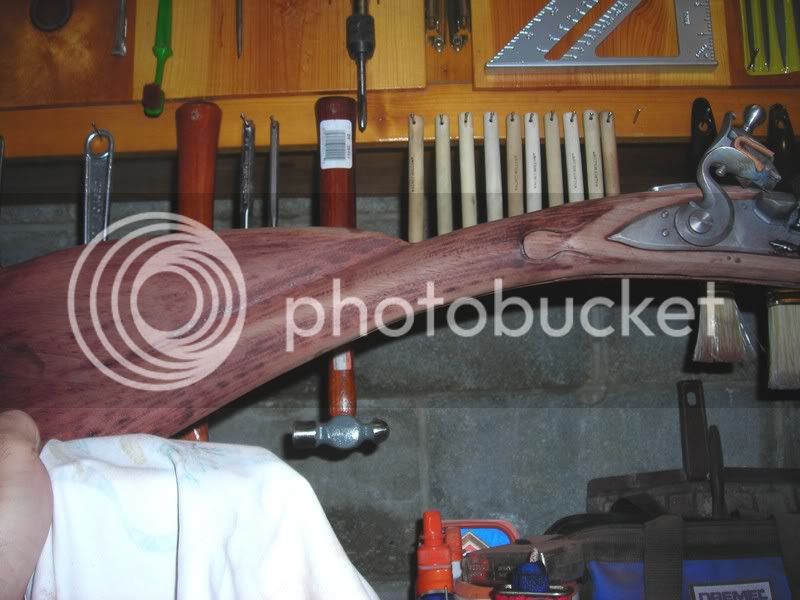
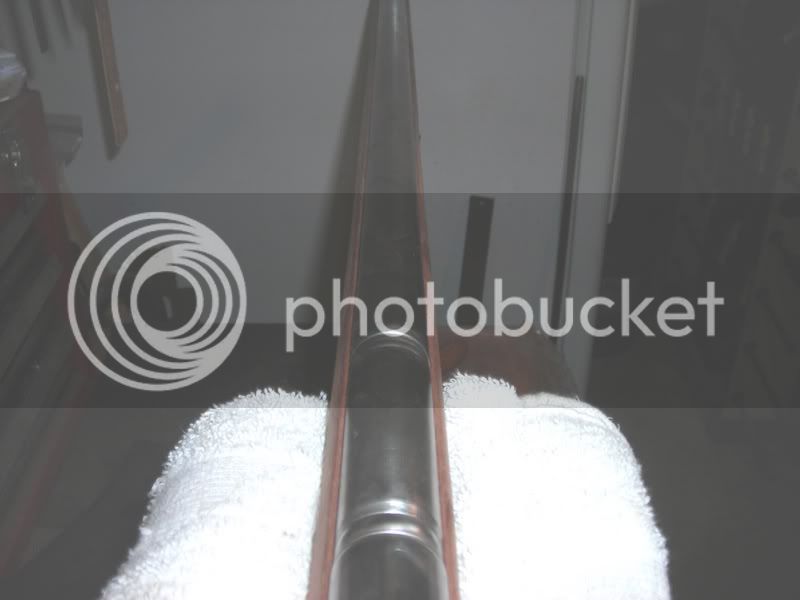
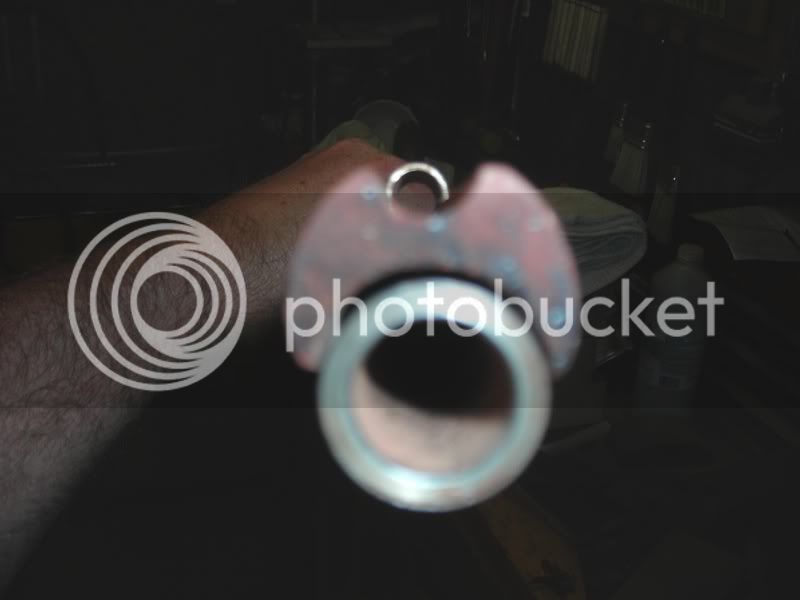
The section under the comb where the ballister starts to form and meet the wrist.
I was sanding and shaping this area, but was just trying to make it look pleasing.
Wasnt trying to get any certain type of look.
I have not seen any sideplates inletted.
I was wandering that myself when I received the kit.
Maybe others might know. If need be I would inlet this area.
Thanks again for everyones help. Check these pics and let me know how it looks
Mowrey50 said:STOCK GRAIN: I see a bit too much open pores or grains for my liking. Did you whisker the wood at all? I also don't use fillers per se, but have the best results on stocks by wet-sanding an oil finish, as the sanding dust will help smooth out and fill in large open grain areas.
You DO realize that walnut, European or American, is somewhat of an open grained wood?”¦and that these arms were originally stocked in European walnut? Also, I am not sure how much trouble the original gunstockers would have gone to in filling the pores. They didn't use sandpaper, and they were trying to fill a bunch of orders as quickly as they could. Whiskering would not hide the pores. Perhaps the repeated "finishing" the end user had to perform due to the non durable low tech finishs available may have eventually filled the pores.
Mowrey50 said:BARREL & FORESTOCK: Not being sure which Tuelle or era you were attempting to re-create, most I see have the forestock end before the barrel and have a trimming of the stock near the muzzle too. I could post some pictures if you need references.
Since this kit comes from Track of the Wolf, it is sold as a Tulle Fusil de Chasse, which implies the smaller calibered, thus lighter weight arm than the military versions. They offer a "C" and a "D" version, with "Fin" options. From what I've read, a de Chasse stock ends at the muzzle, or pretty durn close to it. Heck yeah! Posting pix would be great, and it would be extremely useful to know the bore sizes as well.
Mark
Tom
The side plates on Tulle's are inletted flush with the wood.
Some good points have been made about finishing.
Most trade guns were made quickly and without a high degree of finish work. That said, it looks like you have chosen a fancier grade of gun and so a little more finish work may be justified as compared to common trade gun, just don't over do it.
Is this your first gun? You are doing very well.
My first couple of guns were broken down to reuse the parts over 35 years ago. LOL I was too ashamed of them to let anyone see them. You've got me beat by a mile.
Regards, Dave
The side plates on Tulle's are inletted flush with the wood.
Some good points have been made about finishing.
Most trade guns were made quickly and without a high degree of finish work. That said, it looks like you have chosen a fancier grade of gun and so a little more finish work may be justified as compared to common trade gun, just don't over do it.
Is this your first gun? You are doing very well.
My first couple of guns were broken down to reuse the parts over 35 years ago. LOL I was too ashamed of them to let anyone see them. You've got me beat by a mile.
Regards, Dave
Guest
Hi Dave,
Thanks for the info.
I have removed a lot of wood.
The stock is very slender now.
I cant believe that much wood had to come off.
But it looks so much better.
I appreciate all the input everyone has given.
Yes this is my first gun kit.
I was very nervous about attempting it also.
Ill post more pics later.
Thanks again.
Tom
Thanks for the info.
I have removed a lot of wood.
The stock is very slender now.
I cant believe that much wood had to come off.
But it looks so much better.
I appreciate all the input everyone has given.
Yes this is my first gun kit.
I was very nervous about attempting it also.
Ill post more pics later.
Thanks again.
Tom
"From what I've read, a de Chasse stock ends at the muzzle,"
I have studied these guns extensivly before building one a couple of years ago, the stock should end short of the barrel at least 1/2 inch more would not be uncommon, this will prevent the burning of the wood at the end of the barel.and the wood will tapper out to the end for 2-4 inches, the side plate would normaly stand proud slightly from the wood
I have studied these guns extensivly before building one a couple of years ago, the stock should end short of the barrel at least 1/2 inch more would not be uncommon, this will prevent the burning of the wood at the end of the barel.and the wood will tapper out to the end for 2-4 inches, the side plate would normaly stand proud slightly from the wood
Similar threads
- Replies
- 66
- Views
- 4K
- Replies
- 21
- Views
- 731
- Replies
- 8
- Views
- 410
Latest posts
-
-
-
-
Edenton Historical Commission articles on hunting bags and accoutrements
- Latest: PathfinderNC
-
-
-



